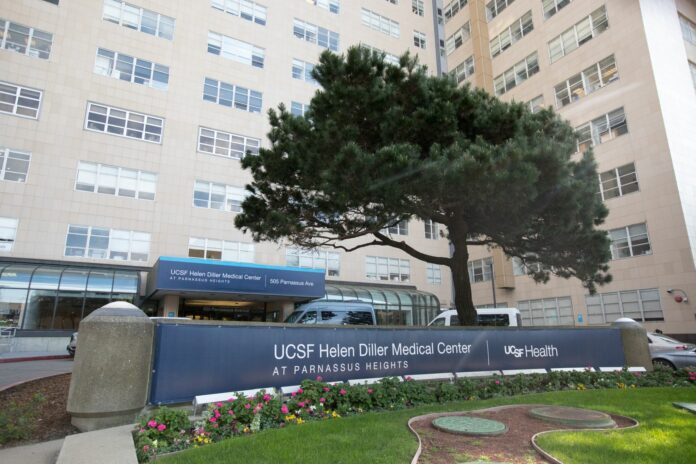By Amy Graff, SFGATE
Published
-

UCSF Hellen Diller Medical Center Hospital in San Francisco, Calif. on March 20, 2020. The Bay Area is under a shelter-in-place order due to the the COVID-19 coronavirus.
UCSF Hellen Diller Medical Center Hospital in San Francisco, Calif. on March 20, 2020. The Bay Area is under a shelter-in-place order due to the the COVID-19 coronavirus.
Photo: Douglas Zimmerman/SFGate
Photo: Douglas Zimmerman/SFGate
UCSF Hellen Diller Medical Center Hospital in San Francisco, Calif. on March 20, 2020. The Bay Area is under a shelter-in-place order due to the the COVID-19 coronavirus.
UCSF Hellen Diller Medical Center Hospital in San Francisco, Calif. on March 20, 2020. The Bay Area is under a shelter-in-place order due to the the COVID-19 coronavirus.
Photo: Douglas Zimmerman/SFGate
As coronavirus cases in California continue to climb, hospitals in a handful of counties are filling up with COVID-19 patients, and San Francisco is taking on some of the overflow.
As of Monday afternoon, the University of California, San Francisco (UCSF), said it had three patients from Imperial County and five from San Quentin.
At San Francisco General, 69 people were hospitalized with confirmed COVID-19 as of Monday afternoon and 16 are transfers. Of those, six are in acute care and ten in the ICU.
Last week, the city said in a release that the number of hospitalizations has increased more than 50% over seven days, “rising from 43 on June 22 to 67 on June 29, including 18 patients transferred from San Quentin State Prison, and Fresno and Imperial counties.”
Stanford Hospital just south of San Francisco has also taken in some patients from outside the Bay Area.
UCSF professor Peter Chin-Hong said it’s not unusual for hospitals to care for patients outside their counties in emergency situations.
“It’s part of the response that we have set up in hospitals in California,” said Chin-Hong. “If there’s a wildfire or any other disaster, hospitals share resources. It’s typical in disaster situations.”
Chin-Hong said the first COVID-19 patients in the Bay Area at the start of the pandemic were transferred to UCSF as the hospital specializes in unusual cases.
“If there’s something strange, you send it to the university hospital that has more resources,” he said.
California Gov. Gavin Newsom delivered a similar message at his Monday briefing, saying that transporting patients from a county with a surge to one with more capacity in hospitals is part of the pandemic plan.
“It’s about collaboration, it’s about sharing, it’s about a detailed plan and procedure that we mapped out at the beginning of the pandemic,” he said.
COVID-19 hospitalizations are up 50% in California over the past two weeks, with the number of hospital beds occupied by COVID-19 patients going from 3,868 to 5,790 people, according to data from the state.
“I think it’s about the highest we’ve been since March-April,” said Chin-Hong. “The scary thing is that this isn’t the peak yet, and we’re expecting to get more and more especially after 4th of July. At the end of the day, it’s going to be higher than we were in the beginning. The fear is we could reach full capacity.”
While the number of occupied beds is rising, only 8% of the state’s hospital beds are in use. But Newsom noted this number is misleading and utilization is significantly higher in certain parts of the state.
In Imperial County, for example, hospitals have been at near-capacity for weeks. The county transferred some 500 Coronavirus patients to hospitals outside the region, including some to the San Francisco Bay Area. The mostly rural county on the Mexico border with a population of about 180,000 has had a positive rate hovering around 20%. Health experts largely agree that cross-border traffic with Mexicali is at least partly to blame for a surge since the middle of May.
San Quentin Prison has also experienced a major outbreak due to a mismanaged transfer of inmates from the California Institution for Men in Chino. As of Monday evening, 1,355 prisoners at the Marin County facility had tested positive.
The Associated Press contributed to this story.
Amy Graff is the news editor for SFGATE. Email her: [email protected].







